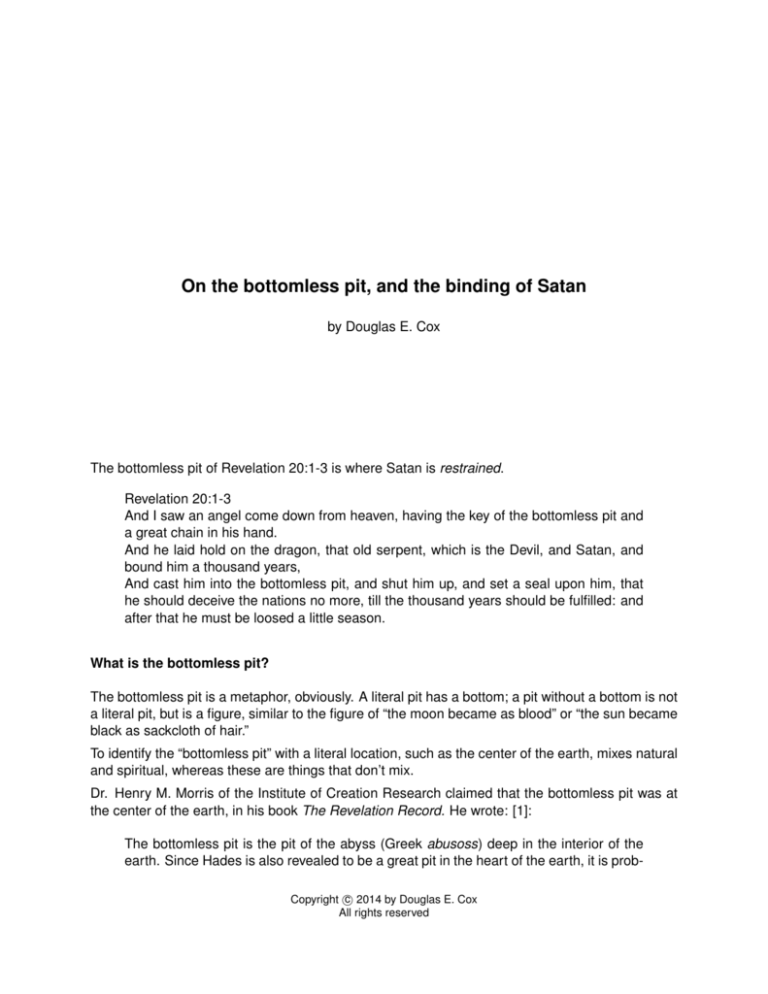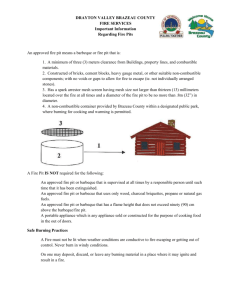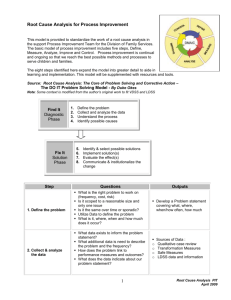
On the bottomless pit, and the binding of Satan
by Douglas E. Cox
The bottomless pit of Revelation 20:1-3 is where Satan is restrained.
Revelation 20:1-3
And I saw an angel come down from heaven, having the key of the bottomless pit and
a great chain in his hand.
And he laid hold on the dragon, that old serpent, which is the Devil, and Satan, and
bound him a thousand years,
And cast him into the bottomless pit, and shut him up, and set a seal upon him, that
he should deceive the nations no more, till the thousand years should be fulfilled: and
after that he must be loosed a little season.
What is the bottomless pit?
The bottomless pit is a metaphor, obviously. A literal pit has a bottom; a pit without a bottom is not
a literal pit, but is a figure, similar to the figure of “the moon became as blood” or “the sun became
black as sackcloth of hair.”
To identify the “bottomless pit” with a literal location, such as the center of the earth, mixes natural
and spiritual, whereas these are things that don’t mix.
Dr. Henry M. Morris of the Institute of Creation Research claimed that the bottomless pit was at
the center of the earth, in his book The Revelation Record. He wrote: [1]:
The bottomless pit is the pit of the abyss (Greek abusoss) deep in the interior of the
earth. Since Hades is also revealed to be a great pit in the heart of the earth, it is probc 2014 by Douglas E. Cox
Copyright All rights reserved
able that the pit of the abyss is either the same as Hades or at least connected directly
with it. It seems clear there are a number of different prisons in Hades. Tartarus, where
the twice-fallen angels are confined, is one of these.
Commenting on Revelation 9:2, Morris wrote: [2]
The “bottomless pit” which he forthwith unlocks is literally “the pit of the abyss.” The
word “abyss” comes from roots meaning “without depth” and so is properly translated
“bottomless.” It is apparently at the very center of the earth and so, in truth, has no
bottom. Its boundaries in all directions are all ceilings; one cannot go down in any
direction. The pit of this abyss of Hades is apparently one of its imprisoning cells, and
it is only this one to which Satan actually receives the key.
There is no such thing as a literal pit that extends to the center of the earth, except in sciencefiction, or fantasy, fairy tales, and the like. The laws of thermodynamics prevent it. Morris confused
natural things with spiritual things. The idea of a “bottomless pit” in Revelation is not natural, but a
spiritual concept, and a figure, or metaphor.
The physics of materials under very high pressure won’t allow any opening or a “pit” in the earth’s
deep interior. The outer core of the earth, at a depth of about 1,790 miles, or 2,890 km, is thought
to be molten, as shear waves of earthquakes do not propagate through it. How could there be a
“pit” in molten rock at very high pressure? Even in a lake, or in the ocean, where the pressure
is much less, it is impossible to dig a pit! Everywhere the water is scooped out, other water
immediately flows in. And it is similar deep in the earth where there is very high pressure. Fluids
from the surrounding rock, or molten rock would immediately fill any space.
Consider the metaphor of “chains of darkness.” Are these chains literal? Are they made of metal,
such as steel? Of course not! “Chain” is used poetically, and connected with “darkness,” which is
associated with being deceived, or ignorant.
Jude 1:6
And the angels which kept not their first estate, but left their own habitation, he hath
reserved in everlasting chains under darkness unto the judgment of the great day.
How can a literal chain, however heavy, or strong, bind a spirit?
Does the bottomless pit in Revelation 20:1 have a literal lock? Why does it need a key? Is the key
a literal key? Why say the pit is literal, and located at the earth’s center, if the key is a figurative
one? And what about that chain, is it a literal chain? It is held by an angel; no doubt angels can
carry a chain large enough for a ship’s anchor!
Clearly, the earth is not a spirit-tight canister, with Satan at its center, rotating once a day and
orbiting the sun once a year. The “bottomless pit” is not a literal location in the earth, but a figure.
It is a term used in Revelation 9:1-2, 11; 11:7; 17:8, and links these scriptures together; thus, for
example, it identifies the beast ascending from the bottomless pit in 11:7 as Satan.
2
What is the thousand years?
Other scriptures link it to an indefinite number [Psalm 50:10], the human life-span [Psalm 90:4],
a “day” [2 Peter 3:8], “yesterday” and “a watch in the night” [Ecclesiastes 6:6], etc. All of these
references illuminate the use of the number by John in Revelation 20.
Jewish tradition and early Christian authors such as Justin linked the thousand years of Revelation
20 to the lifetime of Adam, who died at age 930, before a thousand years had expired. Here, the
“day” in which he was to die is identified with a thousand years. The idea was stated in the Book
of Jubilees, which says of Adam:
Jubilees 4:30
And he lacked seventy years from one thousand years, for a thousand years are like
one day in the testimony of heaven and therefore it was written concerning the tree of
knowledge, “In the day you eat of it you will die.” Therefore he did not complete the
years of this day because he died in it.
2 Peter 2:8 associates a thousand years with the present age, the age of the church, rather than
a future millennial age. Charles Evan Hill commented, “this would suggest that for John too the
thousand-year figure would be a cipher appropriate for the present age.” [3]
The time for which Satan is bound corresponds to the time for which individual saints reign with
Christ.
How is Satan bound?
Jesus spoke of the binding of Satan, who is referred to as the “strong man.”
Mark 3:22-27
And the scribes which came down from Jerusalem said, He hath Beelzebub, and by
the prince of the devils casteth he out devils.
And he called them unto him, and said unto them in parables, How can Satan cast out
Satan?
And if a kingdom be divided against itself, that kingdom cannot stand.
And if a house be divided against itself, that house cannot stand.
And if Satan rise up against himself, and be divided, he cannot stand, but hath an end.
No man can enter into a strong man’s house, and spoil his goods, except he will first
bind the strong man; and then he will spoil his house.
This indicates that Jesus bound the “strong man.” That is, he overcame him. And he said to his
disciples:
Matthew 16:19
And I will give unto thee the keys of the kingdom of heaven: and whatsoever thou shalt
bind on earth shall be bound in heaven: and whatsoever thou shalt loose on earth shall
be loosed in heaven.
3
In the apostolic age, Satan was bound, and the apostles “reigned with Christ.” [Ephesians 2:6]
The nations were enlightened by the gospel.
John said, in Revelation 20:4, that he saw “the souls of them that were beheaded for the witness
of Jesus, and for the word of God” and that “they lived and reigned with Christ a thousand years.”
What kind of “beheading” is it?
I take it to be metaphorical; it refers to the “old man” which must be “mortified” in the life of a
believer. [Romans 8:13, Colossians 3:5] Paul wrote,
“And be renewed in the spirit of your mind;” [Ephesians 4:23] and “Let this mind be in you, which
was also in Christ Jesus.” [Philippians 2:5] This is what is meant by the “first resurrection,” and
reigning with Christ. Christians who overcome Satan, reign with Christ, for a limited time, which is
the duration of their lives in this world. It is represented by “a thousand years.”
In Revelation 11:7, the beast that ascends from the bottomless pit, (Satan) makes war with the
two witnesses (the Spirit, and the word of God) and kills them. Jesus said the saints would have
the power to “bind and loose,” and evidently this is how Satan ascends from the pit, by seducing
Christians.
Also see William Milligan’s discussion of Revelation 20, in his commentary. [4]
References
1. Henry Madison Morris, The Revelation record: a scientific and devotional commentary on the
book of Revelation. Tyndale House Publishers, Inc., 1983. p. 156.
2. Ibid ., p. 157.
3. Charles Evan Hill, Regnum caelorum: patterns of millennial thought in early Christianity. Wm.
B. Eerdmans Publishing, Grand Rapids, Mich. 2001. p. 233.
4. William Milligan, The Book of Revelation . Hodder and Stroughton, London. 1889.
4







